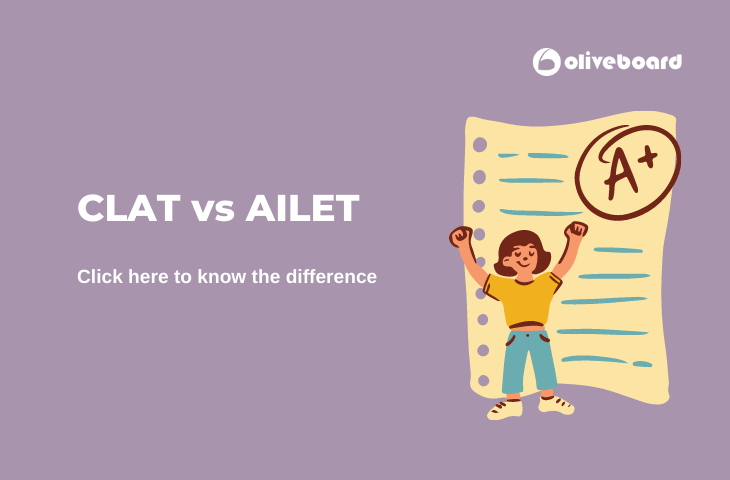Last updated on April 7th, 2022 at 09:28 am
CLAT and AILET are the two most popular legal entrance exams in India, according to the number of applicants. Both legal entrance examinations provide applicants with lucrative possibilities to get admission to prestigious law courses and universities around the country. Still, one of the most contentious issues among students is whether CLAT or AILET is the preferable option. We have highlighted their significant distinctions, test patterns, and other essential factors in this post on CLAT Vs AILET, as well as a comparison of both law entrance examinations.
CLAT vs AILET – Highlights
| Features | CLAT LLM Pattern | AILET LLM Pattern |
|---|---|---|
| Exam mode | Pen-paper mode | Pen-paper mode |
| Exam duration | 2 hours | 1 hour 30 minutes |
| Subjects | Constitutional Law, Jurisprudence, other law subjects including contemporary issues | Criminal Law, Constitutional Law, Law of Contract, Jurisprudence, Law of Tort and International Law |
| Type of questions | Objective as well as subjective questions | Multiple-choice questions |
| Total questions | 120 multiple-choice questions | 102 questions 100 multiple-choice questions 2 Descriptive questions (there will be 8-10 descriptive questions, out of which the candidate has to attempt only two questions) |
| Total marks | 120 marks | 150 marks |
| Marking scheme | +1 for a correct answer -0.25 for an incorrect answer | Multiple-choice questions: +1 for a correct answer -0.25 for an incorrect answer Descriptive questions: Each question carry 25 marks |
CLAT Vs AILET: Eligibility criteria
Eligibility Criteria for CLAT 2022
- According to CLAT 2022 eligibility requirements, candidates interested in taking the test should have finished their Class 12 or any comparable examination from a recognised board.
- CLAT requires a minimum score of 45 percent for applicants in the general, OBC, and other categories, and 40 percent for candidates in the SC and ST categories.
- Candidates who are taking their Class 12 final test can also apply for CLAT, but they must fulfil the entrance conditions.
- There is no upper age limit for taking CLAT.
AILET 2022 Eligibility Criteria
- According to the AILET 2022 qualifying requirements, candidates must have a minimum passing score of 50% in 10+2 or comparable examinations.
- AILET is an option for candidates taking the Class 12 test.
- There is no upper age limit for applicants who wish to participate in AILET 2022.
CLAT vs AILET: Exam Pattern
| Subjects | Question and Marks for CLAT | Question and Marks for CLAT |
|---|---|---|
| English including Comprehension | 28-32 questions of 1 mark each | 50 questions of 1 mark each |
| General Knowledge including Current Affairs | 35-39 questions of 1 mark each | 30 questions of 1 mark each |
| Quantitative Techniques for CLAT Elementary Mathematics for AILET | 13-17 questions of 1 mark each | – |
| Legal Aptitude/ Reasoning | 35-39 questions of 1 mark each | – |
| Logical Reasoning | 28-32 questions of 1 mark each | 70 questions of 1 mark each |
| Total | 150 questions and marks | 150 questions and marks |
CLAT vs AILET: Which is better?
CLAT and AILET are equally good in that they both provide opportunities for admission to India’s top National Law Universities. Candidates may only obtain admission to NLU Delhi through AILET. Candidates can, on the other hand, gain admission to 22 NLUs in India through CLAT.
Aspirants want to discover which law entrance tests are the most difficult to pass before taking them. When comparing the amount of candidates per seat, AILET is clearly a more difficult exam than CLAT. It may be verified as follows:
- CLAT admits over 60,000 students to 2,644 undergraduate and 914 graduate slots.
- Approximately 19,000 applicants compete for 110 BA LLB slots, 70 LLM places, and 18 PhD seats.
Thus, roughly 20 students compete in CLAT for a place at CLAT participating NLUs, whereas over 100 individuals compete in AILET for a seat at NLU, Delhi.
Conclusion
It’s worth noting that the vast majority of applicants apply for both the AILET and CLAT tests. It is more difficult to gain admission to NLU Delhi because it is one of India’s top five NLUs. The difference in difficulty between the CLAT and AILET question papers can be explained by the fact that the latter test features more difficult problems in Legal Aptitude, which are based on basic legal issues. Furthermore, the CLAT Consortium has changed the exam paper to make it simpler for applicants by increasing the number of comprehensive types of questions.

The most comprehensive online preparation portal for MBA, Banking and Government exams. Explore a range of mock tests and study material at www.oliveboard.in
